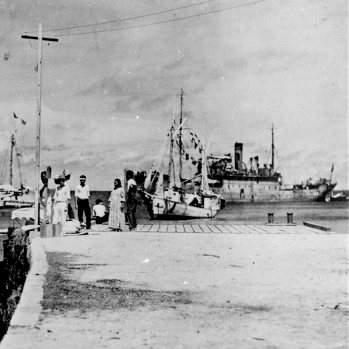July 24 is Amelia Earhart Day

image – history.com [since scrubbed from site]
Earhart vanished without a trace on July 2, 1937, during her attempt to circumnavigate the globe. Despite the likelihood that the plane was never found because it crashed into the Pacific Ocean and sank, theories about her disappearance persist to this day, running the gamut from midair abduction by aliens to a secret move to New Jersey to live under an assumed name.
One popular hypothesis claims the Japanese captured Amelia Earhart and her navigator Fred Noonan, torturing and executing them or holding them in secret for the rest of their lives. Some claim Earhart was a spy for the U.S. Others say she was one of many English-speaking women forced to make radio broadcasts as Tokyo Rose, although propagandists wishing to demoralize American servicemen surely would have seen the benefit in using her real name.
On July 9, 2017, the History Channel aired Amelia Earhart: The Lost Evidence, featuring a photograph that showed two Caucasian people on a dock at Jaluit Atoll and a vessel carrying something that looked like plane wreckage in the background.
A military history blogger scouring archival images son found the photo had been taken in 1935, two years before the crash. This revelation called into question the veracity of the entire documentary. The cable channel has since canceled reruns and deleted streaming video of its program. It also released this statement:
“HISTORY has a team of investigators exploring the latest developments about Amelia Earhart and we will be transparent in our findings. Ultimately, historical accuracy is most important to us and our viewers.”
As of January 2024, I have been unable to find any information regarding the investigation’s conclusion. Please let me know if you’ve seen any so I can update this post.
No matter the truth of her death, we should all celebrate the life and accomplishments of this extraordinary woman.
Happy Amelia Earhart Day!
![]()

 Today is Gorgeous Grandma Day, created by author Alice Solomon. After graduating from Wellesley College in 1984, at age 50, she felt she and her generation had been written off and branded “senior citizens” by society.
Today is Gorgeous Grandma Day, created by author Alice Solomon. After graduating from Wellesley College in 1984, at age 50, she felt she and her generation had been written off and branded “senior citizens” by society. Today is the National Day of the Cowboy, always observed on the fourth Saturday of July. On March 18, 2016, Idaho became the 11th state to pass a law recognizing the holiday.
Today is the National Day of the Cowboy, always observed on the fourth Saturday of July. On March 18, 2016, Idaho became the 11th state to pass a law recognizing the holiday.